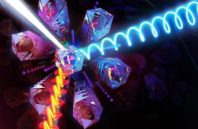One of the leading challenges for autonomous vehicles is to ensure that they can detect and sense objects–even through dense fog. Compared to the current visible light-based cameras, infrared cameras can offer much better visibility through the fog, smoke, or tiny particles that can scatter the visible light.
Within the air, mid-infrared light scatters much less compared to other visible or other infrared light waves. Infrared (IR) cameras can also see more effectively in the dark, when there is no visible light. However, currently the deployment of IR cameras is limited by their heavy cost and scarcity of effective materials. This is where materials, that possess unique optical properties in the IR and can be scalable, might make a difference in providing better object identification in several technologies including autonomous vehicles.
A new material developed by scientists at the USC Viterbi School of Engineering (Los Angeles, CA) and the University of Wisconsin (Madison, WI) along with researchers from Air Force Research Laboratories, University of Missouri, and J.A. Woollam Co., might show promise for such IR detection applications as autonomous vehicles, emergency services and even manufacturing.

 (585) 768-2513
(585) 768-2513

